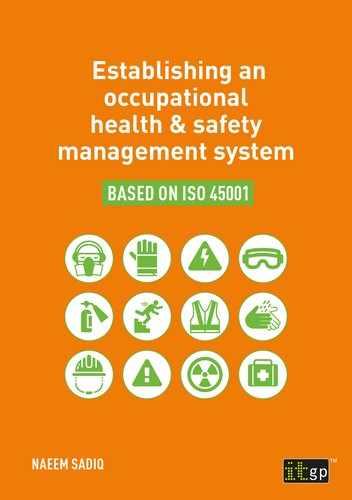CHAPTER 19: CONTINUAL IMPROVEMENT
19.1 Requirements
Continual improvement of the OHSMS is a mandatory component of the PDCA cycle, as well as a mandatory requirement of ISO 45001. The Standard categorically states that an organisation shall continually improve the suitability, adequacy and effectiveness of its OHSMS. The Standard further goes on to identify the mechanisms to be used by an organisation to continually improve these three parameters. These are:
•Enhancing OH&S performance by reducing hazards and incidents, minimising OH&S risk, reducing factors that contribute to ill health such as noise, dust and fumes, improving compliance, meeting OH&S objectives, etc.
•Promoting a culture that supports an OHSMS. This could mean more visible involvement of senior management, supporting (as opposed to reprisals) those who identify hazards and shortcomings of the system, encouraging participation and views of employees, involving workers in setting goals, conducting investigations and writing new procedures, etc.
•Promoting workers’ participation in implementation of continual improvement programmes. Clearly this is to re-emphasise the importance of workers’ participation in improving suitability, adequacy and effectiveness of the OHSMS.
•Communicating the results of continual improvement to workers and workers’ representatives (where they exist) is now a requirement of the Standard. This may be seen both as a matter of factual feedback as well as a positive reinforcement tool for motivation of workers.
•Maintaining and retaining documented information regarding continual improvement. There may not be a single place or source for information on continual improvement, and it may be spread and extracted from a number of sources such as OH&S objectives, legal compliance, audit results, performance data, management reviews, etc.
19.2 Opportunities for continual improvement
An organisation must always be on the lookout for possibilities of continual improvement. There may be numerous occasions or events that offer new improvement opportunities that could be capitalised upon. A few such examples are listed below:
•New technology is always an opportunity for continual improvement. It may involve less intensive physical effort for workers, better process safety, less noise, dust, heat or smoke, better ergonomics and higher productivity. Hence an organisation must always remain vigilant for consideration and adoption of technological changes as a means of improving its OH&S system.
•Best practices used in similar industries often provide a benchmark for improving one’s own practices and processes.
•Suggestions and recommendations of workers, contractors, consultants, suppliers, regulators and other stakeholders could provide useful inputs for continual improvement. It is therefore appropriate for an organisation to create greater opportunities and occasions for discussion, feedback and exchange of ideas with its interested parties.
•Organisations learn and develop better understanding of OH&S issues as they gain experience and maturity. Compilation, study and analysis of one’s own data and experience is a potential source for learning and improvement.
•An organisation must constantly be on the lookout for new knowledge and research on how materials and processes could impact the OH&S of its personnel. The nature and extent of health risks posed by toxic or hazardous materials are often dependent on the exposure level, the exact material one is exposed to, the concentration of the material, the route into the body and the amount absorbed by the body (the dose). The individual susceptibility of the user may also play an important role. Lead, methylene chloride, asbestos, polyvinyl chloride, acetone, cadmium, volatile organic compounds, silica, acids, enzymes and fibre glass are just a few examples of such harmful materials. Based on ever-advancing scientific knowledge, the list of hazardous materials and their impacts is bound to change and should be kept under constant review. New or improved materials that offer lower OH&S risks are another opportunity for an organisation to consider in its endeavour for continual improvement.
•An organisation can improve by improving the competence level of its employees. Constant training, awareness and updating employee skills and knowledge can be powerful tools for continual improvement.
•Productivity, defined as the ratio between output and input, is considered as a KPI of an organisation.
Achieving higher levels of OH&S performance by using fewer resources, could therefore be another means for achieving continual improvement. Streamlining, process improvement, simplification, reducing process steps, reducing the number of employees performing the same task or improving process cycle time could also be some of the ways an organisation could seek continual improvement.
